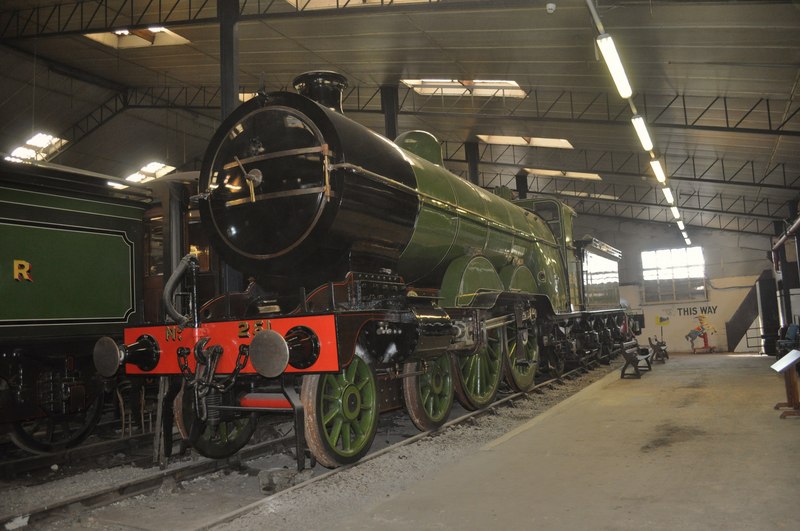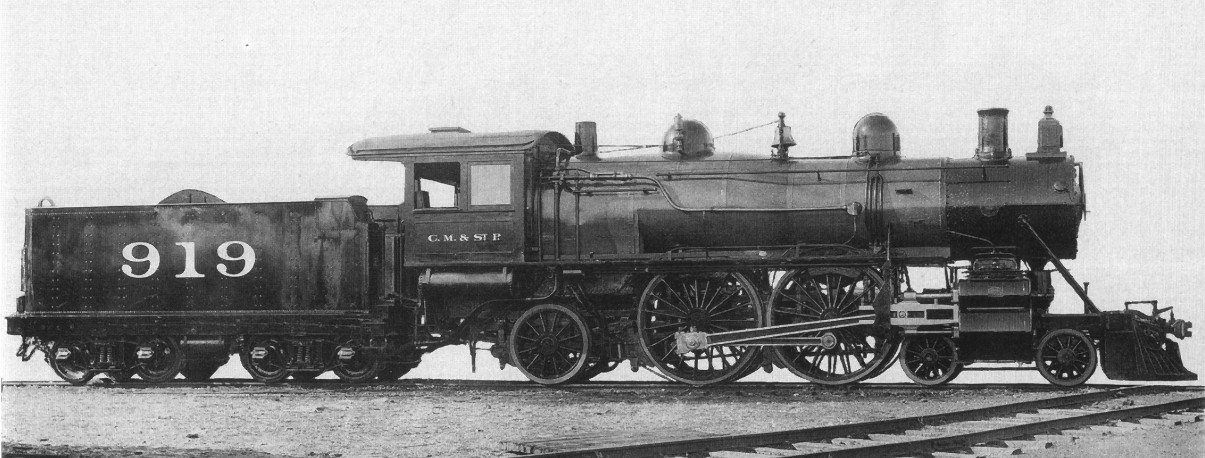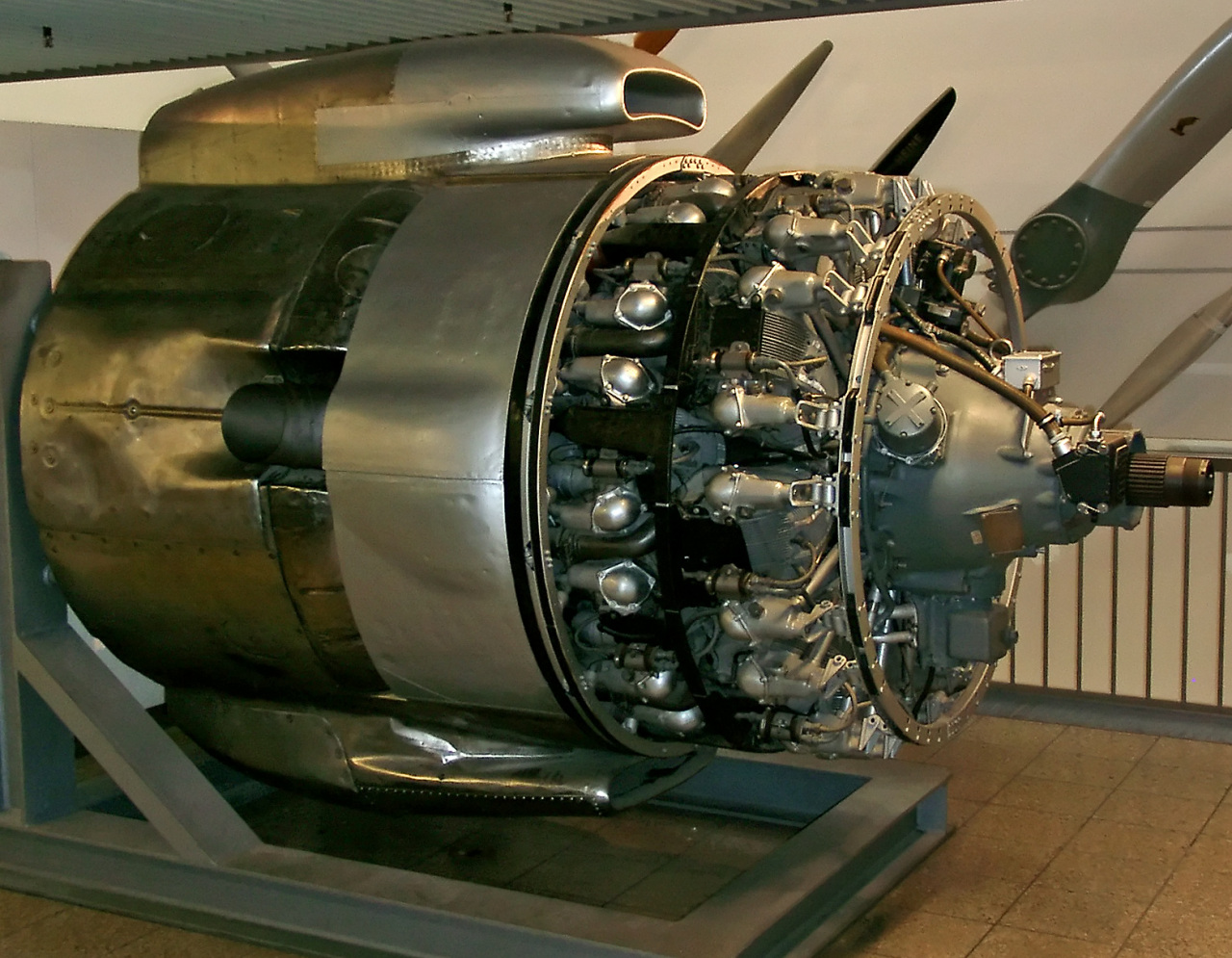|
GNR Class C1 (large Boiler)
The Great Northern Railway (GNR) Class C1 is a type of 4-4-2 steam locomotive. One, ex GNR 251, later LNER 2800, survives in preservation. Much like their small boiler cousins, they were capable of reaching speeds of up to 90 mph (145 km/h). They were also known as ''Large Atlantics''. Development The C1 Class, as it was known under both GNR & LNER classifications, was designed by Henry Ivatt as an enlarged version of what became the LNER C2 Class. The principle of the design was to produce a powerful, free-steaming engine to haul the fastest and heaviest express trains on the Great Northern. They could thus be seen as the start of the East Coast 'Big Engine' policy. None were ever named. First engine and improvements The first engine, No. 251, was introduced in 1902, with eighty more being built at Doncaster Works between 1904 and 1908. Although they suffered from a number of teething troubles, the Atlantics were generally very successful. They were original ... [...More Info...] [...Related Items...] OR: [Wikipedia] [Google] [Baidu] |
Photographic Grey
Photographic grey, also known as works grey, was a paint scheme commonly applied to steam locomotives during the period before colour photography became commonplace. It was applied to allow sharper, more detailed images of the locomotive to be recorded. The first photographs of railways and their locomotives were made by private individuals, but by the 1860s the railway companies themselves were keen to create official photographs of the highest quality possible of their latest designs, which led to the adoption of photographic grey in railway photography. Use Railway companies wished to record their latest locomotives for use in publicity material and advertisements, and as a technical record of their work. This was especially the case in the United Kingdom, where all but the smallest of the 'pre-grouping' companies owned their own locomotive works and designed and built their own railway engines. For the numerous private locomotive builders it was especially important to hav ... [...More Info...] [...Related Items...] OR: [Wikipedia] [Google] [Baidu] |
Slide Valve
The slide valve is a rectilinear valve used to control the admission of steam into and emission of exhaust from the cylinder of a steam engine. Use In the 19th century, most steam locomotives used slide valves to control the flow of steam into and out of the cylinders. In the 20th century, slide valves were gradually superseded by piston valves, particularly in engines using superheated steam. There were two reasons for this: * With piston valves, the steam passages can be made shorter. This reduces resistance to the flow of steam and improves efficiency. * It is difficult to lubricate slide valves adequately in the presence of superheated steam. Murdoch's D slide valve The D slide valve, or more specifically Long D slide valve, is a form of slide valve, invented by William Murdoch and patented in 1799. It is named after the hollow central D-sectioned piston. This valve worked by "connecting the upper and lower valves so as to be worked by one rod or spindle, and in maki ... [...More Info...] [...Related Items...] OR: [Wikipedia] [Google] [Baidu] |
LNER Class A3
The London and North Eastern Railway LNER Gresley Classes A1 and A3 locomotives represented two distinct stages in the history of the British "Pacific" steam locomotives designed by Nigel Gresley. They were designed for main line passenger services and later express passenger services, initially on the Great Northern Railway (GNR), a constituent company of the London and North Eastern Railway after the amalgamation of 1923, for which they became a standard design. The change in class designation to A3 reflected the fitting to the same chassis of a higher pressure boiler with a greater superheating surface and a small reduction in cylinder diameter, leading to an increase in locomotive weight. Eventually all of the A1 locomotives were rebuilt, most to A3 specifications, but no. 4470 was completely rebuilt as Class A1/1. The names for the locomotives came from a variety of sources. The first, ''Great Northern'', was named after its parent company. Others were given the names ... [...More Info...] [...Related Items...] OR: [Wikipedia] [Google] [Baidu] |
LNER Gresley Classes A1 And A3
The London and North Eastern Railway LNER Gresley Classes A1 and A3 locomotives represented two distinct stages in the history of the British "Pacific" steam locomotives designed by Nigel Gresley. They were designed for main line passenger services and later express passenger services, initially on the Great Northern Railway (GNR), a constituent company of the London and North Eastern Railway after the amalgamation of 1923, for which they became a standard design. The change in class designation to A3 reflected the fitting to the same chassis of a higher pressure boiler with a greater superheating surface and a small reduction in cylinder diameter, leading to an increase in locomotive weight. Eventually all of the A1 locomotives were rebuilt, most to A3 specifications, but no. 4470 was completely rebuilt as Class A1/1. The names for the locomotives came from a variety of sources. The first, ''Great Northern'', was named after its parent company. Others were given the na ... [...More Info...] [...Related Items...] OR: [Wikipedia] [Google] [Baidu] |
Nigel Gresley
Sir Herbert Nigel Gresley (19 June 1876 – 5 April 1941) was a British railway engineer. He was one of Britain's most famous steam locomotive engineers, who rose to become Chief Mechanical Engineer (CME) of the London and North Eastern Railway (LNER). He was the designer of some of the most famous steam locomotives in Britain, including the LNER Class A1 and LNER Class A4 4-6-2 Pacific engines. An A1 Pacific, '' Flying Scotsman'', was the first steam locomotive officially recorded over 100 mph in passenger service, and an A4, number 4468 '' Mallard'', still holds the record for being the fastest steam locomotive in the world (126 mph). Gresley's engines were considered elegant, both aesthetically and mechanically. His invention of a three-cylinder design with only two sets of Walschaerts valve gear, the Gresley conjugated valve gear, produced smooth running and power at lower cost than would have been achieved with a more conventional three sets of Walschaerts ... [...More Info...] [...Related Items...] OR: [Wikipedia] [Google] [Baidu] |
Finsbury Park With LNER Ivatt Atlantic Geograph-2319243-by-Ben-Brooksbank
Finsbury is a district of Central London, forming the south-eastern part of the London Borough of Islington. It borders the City of London. The Manor of Finsbury is first recorded as ''Vinisbir'' (1231) and means "manor of a man called Finn".Mills, D. (2000). ''Oxford Dictionary of London Place Names''. . Finsbury lay just outside Cripplegate (and on its later construction, Moorgate) in London Wall. At that time, much of the manor was part of the ''"great fen which washed against the northern wall of the City"''. Finsbury gave its name to two larger administrative areas: the Finsbury Division of the Ossulstone Hundred of Middlesex, from the 17th century until 1900, and from 1900 to 1965 the Metropolitan Borough of Finsbury. The Metropolitan Borough included Finsbury (also known as St Luke's) and Clerkenwell. The area should not be confused with Finsbury Park, a public space roughly to the north, which gives its name to its surrounding mainly residential area. Geogr ... [...More Info...] [...Related Items...] OR: [Wikipedia] [Google] [Baidu] |
Booster Engine
A booster engine for steam locomotives is a small two-cylinder steam engine back-gear-connected to the trailing truck axle on the locomotive or the lead truck on the tender. A rocking idler gear permits it to be put into operation by the driver (engineer). It drives one axle only and can be non-reversible, with one idler gear, or reversible, with two idler gears. A booster engine is used to start a heavy train or maintain low speed under demanding conditions. Rated at about at speeds of from , it can be cut in while moving at speeds under and is semi-automatically cut out via the engineer notching back the reverse gear between , depending on the model and design of the booster. A tractive effort of is common, although ratings of up to around were possible. Tender boosters are equipped with side-rods connecting axles on the lead truck. Such small side-rods restrict speed and are therefore confined to switching locomotives, often used in transfer services between yards. Tende ... [...More Info...] [...Related Items...] OR: [Wikipedia] [Google] [Baidu] |
LNER Class K2
The Great Northern Railway Class H2 and H3 (classified K1 and K2 by the LNER) was a class of 2-6-0 steam locomotive designed for mixed-traffic work. The class was created as a locomotive which could haul heavier goods trains at speeds of up to 40 mph. The class were later developed into the more powerful H4 ( LNER K3) class. After formation of the London and North Eastern Railway, the type became known as class K1 and K2 and was adopted as an LNER standard design. They got the nickname "Ragtimers" because of their lively nature when running at speed and their use of Walschaerts valve gear which was uncommon on the GNR at the time. Construction The ten K1s were built at the GNR's Doncaster Works in 1912–1913, to the design of Nigel Gresley. Five batches of K2s, also to the design of Gresley, were built at Doncaster, the North British Locomotive Company, and Kitson and Company between 1914 and 1921. These were the first design to incorporate Gresley's patented double swi ... [...More Info...] [...Related Items...] OR: [Wikipedia] [Google] [Baidu] |
GNR Class H3
The Great Northern Railway (Great Britain), Great Northern Railway Class H2 and H3 (classified K1 and K2 by the London and North Eastern Railway, LNER) was a class of 2-6-0 steam locomotive designed for mixed-traffic work. The class was created as a locomotive which could haul heavier goods trains at speeds of up to 40 mph. The class were later developed into the more powerful GNR Class H4, H4 (LNER Class K3, LNER K3) class. After formation of the London and North Eastern Railway, the type became known as class K1 and K2 and was adopted as an LNER standard design. They got the nickname "Ragtimers" because of their lively nature when running at speed and their use of Walschaerts valve gear which was uncommon on the GNR at the time. Construction The ten K1s were built at the GNR's Doncaster Works in 1912–1913, to the design of Nigel Gresley. Five batches of K2s, also to the design of Gresley, were built at Doncaster, the North British Locomotive Company, and Kitson and Comp ... [...More Info...] [...Related Items...] OR: [Wikipedia] [Google] [Baidu] |
Vulcan Foundry
The Vulcan Foundry Limited was an English locomotive builder sited at Newton-le-Willows, Lancashire (now Merseyside). History The Vulcan Foundry opened in 1832, as Charles Tayleur and Company to produce girders for bridges, switches, crossings and other ironwork following the opening of the Liverpool and Manchester Railway. Due to the distance from the locomotive works in Newcastle-upon-Tyne, it seemed preferable to build and support them locally. In 1832, Robert Stephenson became a partner for a few years. The company had become The Vulcan Foundry Company in 1847 and acquired limited liability in 1864. From the beginning of 1898, the name changed again to The Vulcan Foundry Limited, dropping the word 'company.' Vulcan Halt The site had its own railway station, Vulcan Halt, on the former Warrington and Newton Railway line from to . The wooden-platformed halt was opened on 1 November 1916 by the London and North Western Railway, and closed on 12 June 1965. Steam locomot ... [...More Info...] [...Related Items...] OR: [Wikipedia] [Google] [Baidu] |
Compound Locomotive
A compound locomotive is a steam locomotive which is powered by a compound engine, a type of steam engine where steam is expanded in two or more stages. The locomotive was only one application of compounding. Two and three stages were used in ships, for example. Compounding became popular for railway locomotives from the early 1880s and by the 1890s were becoming common. Large numbers were constructed, mostly two- and four-cylinder compounds, in France, Germany, Austria, Hungary, and the United States. It declined in popularity due to maintenance issues and because superheating provided similar efficiencies at lower cost. Nonetheless, compound Mallets were built by the Norfolk and Western Railway right up to 1952. Introduction In the usual arrangement for a compound engine the steam is first expanded in one or two high-pressure ''(HP)'' cylinders, then having given up some heat and lost some pressure, it exhausts into a larger-volume low-pressure ''(LP)'' cylinder, (or two, - or ... [...More Info...] [...Related Items...] OR: [Wikipedia] [Google] [Baidu] |
Simple Expansion Steam Engine
A compound engine is an engine that has more than one stage for recovering energy from the same working fluid, with the exhaust from the first stage passing through the second stage, and in some cases then on to another subsequent stage or even stages. Originally invented as a means of making steam engines more efficient, the compounding of engines by use of several stages has also been used on internal combustion engines and continues to have niche markets there. The stages of a compound engine may be either of differing or of similar technologies, for example: * In a turbo-compound engine, the exhaust gas from the cylinders passes through a turbine, the two stages being dissimilar. * In a compound steam locomotive, the steam passes from the high-pressure cylinder or cylinders to the low-pressure cylinder or cylinders, the two stages being similar. * In a triple-expansion steam engine, the steam passes through three successive cylinders of increasing size and decreasing pressu ... [...More Info...] [...Related Items...] OR: [Wikipedia] [Google] [Baidu] |


.jpg)

.jpg)



